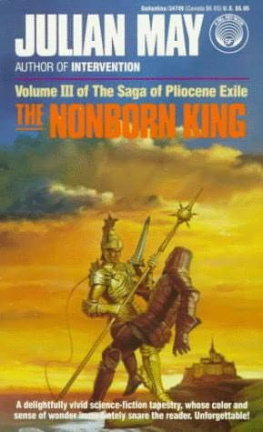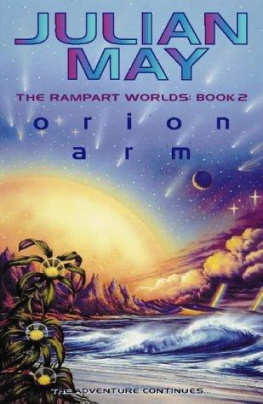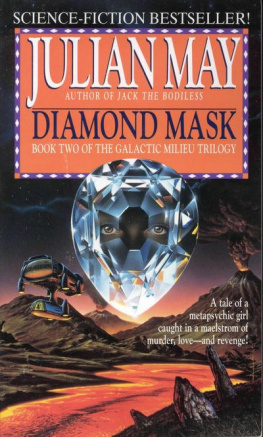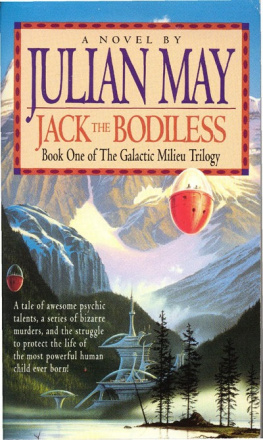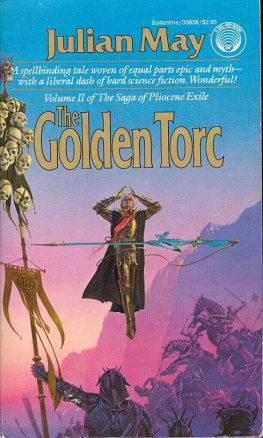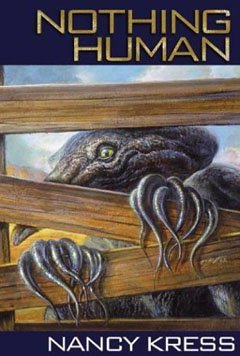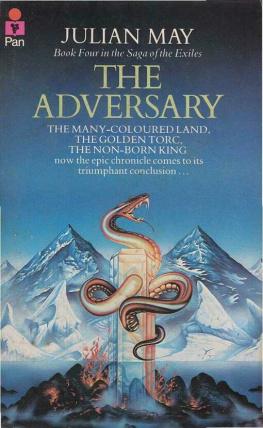The Noborn King
Book 3 of the Exile
Julian May
CONTENTS
The Galactic Milieu and the Pliocene Exile
THE GREAT INTERVENTION OF 2013 OPENED HUMANITYS WAY to the stars. By the year 2110, when the action of the first volume in this saga began, Earthlings were fully accepted members of a benevolent confederation of planet colonizers, the Coadunate Galactic Milieu, who shared high technology and the capability of performing advanced mental operations known as metafunctions. The latterwhich include telepathy, psychokinesis, and many other powershad lurked in the human gene pool from time immemorial, but only rarely were manifest.
The five founding races of the Milieu had observed humanitys development for tens of thousands of years. After some debate, they decided to admit Earthlings to the Milieu in advance of their psychosocial maturation because of the vast metapsychic potential of humanity, which might eventually exceed that of any other race. With the help of nonhumans, people from Earth colonized more than 700 new planets that had already been surveyed and found suitable.
Earthlings also learned how to speed the development of their metapsychic powers through special training and genetic engineering. However, even though the number of humans with operant metafunctions increased with each generation, in 2110 the majority of the population was still normalthat is possessing metafunctions that were either meager to the point of nullity or else latent, unusable because of psychological barriers or other factors Most of the day-to-day socioeconomic activities of the Human Polity of the Milieu were earned on by normals; but human metapsychics did occupy privileged positions in government, in the sciences, and in other areas where high mental powers were valuable to the Milieu as a whole.
At only one period between the Great Intervention and 2110 did it seem that the admission of humanity to the Milieu had been a mistake. This was in 2083, during the brief Metapsychic Rebellion Instigated by a small group of Earth-based humans, this attempted coup narrowly missed destroying the entire Milieu organization. The Rebellion was suppressed by loyalist metapsychic humans and steps were taken to insure that such a disaster never would occur again. A certain number of battered rebel survivors did manage to evade retribution by passing through a unique kind of escape hatch, a one-way time-gate leading into Earths Pliocene Epoch, six million years in the past.
The time-gate was discovered in 2034, during the heady years of the scientific knowledge-explosion subsequent to the Great Intervention. But since the time-warp opened only backward (anything attempting to return became six million years old and usually crumbled to dust), and since it had a fixed focus (a point in Frances RhneRiverValley), its discoverer sadly concluded that it was a useless oddity without practical application.
After the time-gate discoverers death in 2041, his widow, Anglique Guderian, learned that her husband had been mistaken.
The Intervention had seemed to open a Golden Age for humanity, giving it unlimited lebensraum, energy sufficiency, and membership in a splendid galaxy-wide civilization. But even Golden Ages have their misfits in this case, humans who were temperamentally unsuited to the rather structured social environment of the Milieu. As Madame Guderian was to discover, there were fair numbers of these, and they were willing to pay handsomely to be transported to a simpler world without rules. Geologists and paleontologists knew that the Pliocene was an idyllic period, just before the dawn of rational life on our planet. Romantics and rugged individualists from almost all of Earths ethnic groups eventually discovered Madames underground railroad to the Pliocene, which operated out of a quaint French inn located outside the metropolitan center of Lyon.
From 2041 until 2106, the rejuvenated Madame Guderian transported clients from Old Earth to Exile, a presumed natural paradise six million years younger. After suffering belated qualms of conscience about the fate of the time-travelers, Madame herself passed into the Pliocene and operation of her inn was taken over by the Milieu, which had found the time-warp to be a convenient glory hole for dissidents. By 2110, nearly 100,000 time-farers had vanished into an unknown destiny.
On 25 August 2110, eight persons, making up that weeks Group Green, were transported to Exile Richard Voorhees, a grounded starship captain, Felice Landry, a disturbed eighteen-year-old athlete whose violent temperament and latent mind-powers had made her an outcast; Claude Majewski, a recently widowed elderly paleontologist; Sister Amerie Roccaro, a physician and burnt-out priest; Bryan Grenfell, an anthropologist following his lover, Mercy Lamballe, who had preceded him through the gate; Elizabeth Orme, a Grand Master metapsychic who had lost her stupendous mental powers after a brain trauma; Stein Oleson, a misfit planet-crust driller who dreamt of life in a simpler world, and Aiken Drum, an engaging young crook who, like Felice, possessed considerable latent metapsychic power.
Group Green discovered, as other time-travelers had before them, that idyllic Pliocene Europe was under the control of a group of maverick humanoids from another galaxy. The exotics were also exiled, having been driven from their home because of their barbarous battle-religion.
The dominant exotic faction, the Tanu, were tall and handsome. In spite of a thousand-year sojourn on Earth, there were still less than 20,000 of them because their reproduction was inhibited by solar radiation. Since their plasm was compatible with that of humanity, they had for nearly seventy years utilized the time-travelers in breeding, holding Pliocene humanity in benevolent serfdom.
Antagonistic to the Tanu and outnumbering them by at least four to one were their ancient foes, the Firvulag often called the Little People, these exotics were mostly of short stature, although there were plenty of human-sized and even gigantic individuals among them. They reproduced quite well on Pliocene Earth.
Tanu and Firvulag actually constituted a dimorphic racethe former metapsychicaily latent, and the latter possessed of operant metafunctions, mostly limited in power. The Tanu with their higher technology, had long ago developed mind-amplifiers, collars called golden torcs, which raised their latent mind-powers up to operancy. Firvulag did not require torcs to exercise their metafunctions. Certain of their great heroes were the mental equals of the Tanu in aggressive action, but most Firvulag were weaker.
For most of the thousand years that Tanu and Firvulag resided on Earth (which they called the Many-Colored Land), they were fairly evenly matched in the ritual wars fought as part of their battle-religion. The greater finesse and technology of the Tanu tended to counterbalance the superior numbers of the cruder Firvulag. But the advent of time-traveling humanity tipped the scales in favor of the taller exotics. Not only did Tanu-human hybrids turn out to have unusual physical and mental strength, but humans also enhanced the rather decadent science establishment of the Tanu by injecting the expertise of the greatly advanced Galactic Milieu. It had been strictly forbidden for time-travelers to carry sophisticated weaponry back to the Pliocene, and the Tanu were very conservative in the types of military hardware that they permitted their human slaves to build. Nevertheless, it was human ingenuity that eventually gave the Tanu almost complete ascendency over their Firvulag foes (who never mated with humans and generally despised them).
Most of the enslaved time-travelers actually lived a pretty good life under their Tanu overlords. All rough work was done by ramapithecines, small apes who wore simple torcs compelling obedience and who were, ironically, part of the direct hominid line that would climax in Homo sapiens six million years in the future. Humans who occupied positions of trust or engaged in vital pursuits under the Tanu wore gray torcs. These did not amplify the mind, but did allow telepathic communication with the Tanu, who were also able to administer punishment or reward through the device. If psychological testing showed that an arriving time-traveler possessed significant latent metafunctions, the lucky person was given a
Next page
